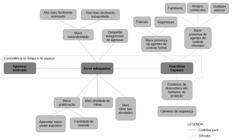Abstract
The large number of studies on the relationship between environmental factors and the occurrence of crimes has resulted in a fragmented state of affairs that makes it hard to establish an integrated view of what these factors are, and how robust the available evidence about each of them is. It is also difficult to establish the different potential interactions that each factor may elicit in different stages of the criminal act. In order to fill this gap, we propose a model of the relationship between built environment and the occurrence of crimes, to structure and unveil these interactions, and outline a series of intermediary factors that help explain the hypothetical causal connections between them. The model is structured in three levels: the four stages of criminal occurrence (target selection, access to target, crime execution and get-away), intermediate factors, and environmental aspects. We carried out an extensive literature review in search of empirical evidence to allow us to estimate with more confidence the proposed relations, and then discussed its implications and indicated some dilemmas about potentially conflicting causal connections revealed by the model. Additionally, we pointed out some aspects about which of the uncertainties are still significant, indicating possible gaps for future studies.
Keywords:
Crime occurrence; Built environment; Environmental factors; Crime prevention; Urban design

 Thumbnail
Thumbnail
 Thumbnail
Thumbnail
 Thumbnail
Thumbnail
 Thumbnail
Thumbnail



